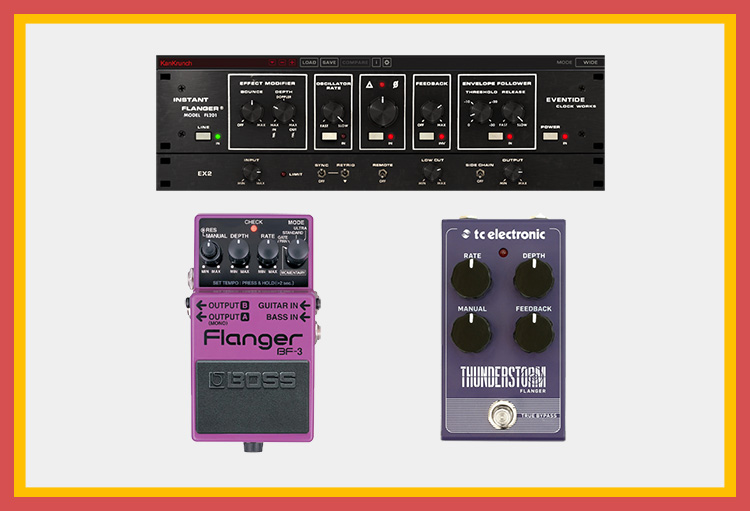A flanger is an audio effect realised by using a delay with very short times (up to a few tens of milliseconds) through which the signal to be processed is passed. These time delays are continuously varied (modulation).
The delayed signal is mixed with the original signal, causing interference and cancellation of the counter-phased frequencies (comb filter effect). This creates a modulation effect (an effect that changes over time) that is often perceived as jet-like, psychedelic or magical.
If you modulate the delay time with an LFO with a long period (less than one second), you get an effect of decay over the entire range of the audio spectrum, similar to the sound of a plane flying by.
It owes its name to the technique used to create it in the 1950s through an accidental discovery: in order to amplify the vocal tone of singer Toni Fisher in the song The Big Hurt, sound engineer Larry Levine played two copies of the same tape in imperfect synchronization using two recording devices.
In doing so, he pressed the flange (flanging) of the coil, which gave one of the two a phase delay. Mixing the two sound tracks, which were thereby phase-shifted, led to the novel effect.
Nowadays, flangers are often used in music production in the studio or as pedals for electric guitars or even electric basses.
What does a flanger sound like?
The flanger gives audio signals a metallic, chorus-like sound that changes dynamically over time. The resulting effect is often described as psychedelic.
- At slow modulation rates, the flanger sounds like a jet.
- At fast modulation rates, it resembles the sound of a chorus effect.
In the following video you can hear very well what this effect can do:

By loading the video, you accept YouTube's privacy policy.
Learn more
Parameters of modern flangers
We will use the Boss BF-3 Flanger as an example to explain the parameters. Most flangers have the same setting options, but some just call them differently.
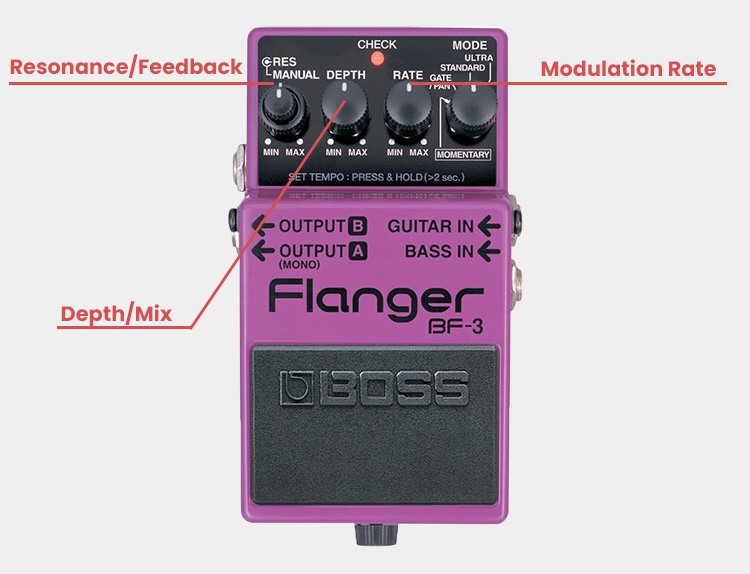
- Depth (or Mix): How much the delay time is modulated. If this control is set to minimum, the flanger remains "static", as the delay time remains constant. If you set Depth to a higher value, the delay time changes strongly with time (i.e. it is modulated).
- Rate (or Modulation Rate): How fast the delay time changes over time. Sonically, you can think of it like this: When the sweep goes up and down, the modulation rate determines the difference in time between the highest and lowest points.
- Resonance (or Feedback): How much of the signal is fed back to the input. With a higher feedback, the sweeping effect becomes more noticeable and the sound becomes "wackier".
What is the difference between a chorus and a flanger?
A chorus sounds as if you double the audio track (voice doubling), while a flanger sounds as if the audio source is in front of a fan (sound colouration).
Both effects are based on duplicating the signal and delaying a copy - but there are differences in the delay times and the number of duplications:
- Chorus uses 5-35ms delay times and can generate several copies of the original signal
- Flanger uses delay times from 1 to 5 ms and generates only one copy of the original signal.
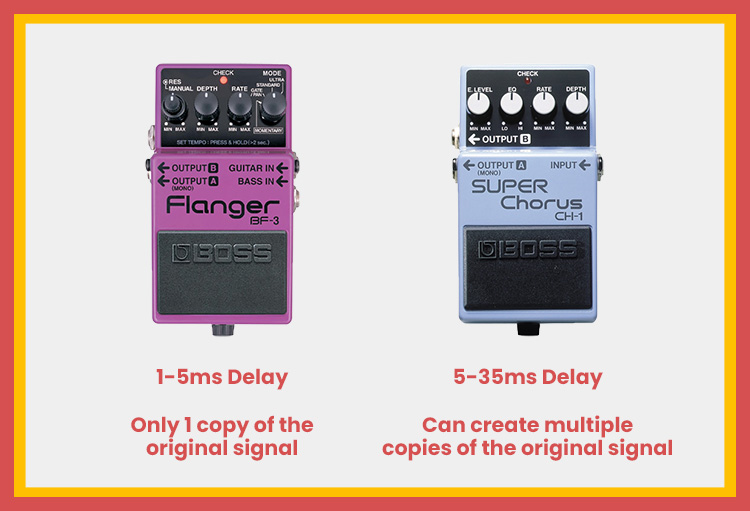
How do I use a flanger in my music productions?
First of all, you should know that the flanger is used very sporadically - not as often as EQs, delay or reverb. The flanger is such a powerful effect that can change the sound of the track so much that you always have to be careful.
But there are always situations where a flanger can sound very good.
Flanger on the distorted guitar in rock
This is a classic: you put a flanger on the distorted electric guitar (no matter if lead or rhythm) to give the guitar a hard, "spacey" sound.
A good example of this is the intro of The Spirit of Radio from Rush - here, the guitar really sounds like it's coming out of an airplane turbine.

By loading the video, you accept YouTube's privacy policy.
Learn more
This kind of effect has been used a lot in rock and heavy metal because it just fits wonderfully. Just put a flanger on the guitar track and then play with the parameters until the sound fits.
In this song, you use a relatively slow modulation speed so that the sound changes slowly to create this kind of jet sound.
Flanger on the vocals for a wide sound
Other good uses for the flanger are vocals, especially backing vocals. This gives the vocals a magical sound that works especially well with harmonising chorus vocals.

By loading the video, you accept YouTube's privacy policy.
Learn more
Here you add the effect only minimally so that the vocals don't sound too alien - the aim is to make the flanger almost unnoticeable.
Flanger on the drums to create experimental sounds
It is also common to apply this effect to the drums to create wacky sounds. The result is not always satisfactory and you have to try a lot of settings to get a good sound.
But every now and then it can sound really good - and it is one thing above all: extraordinary.

By loading the video, you accept YouTube's privacy policy.
Learn more
In this song, the flanger sound fits perfectly on the drums - it is only used a little (I guess with 30% Mix) so that you still hear more of the original signal.
Good modern flangers (analogue and digital)
There are a lot of flangers available these days, both analogue and digital. None of them is better or worse - they are just designed for different situations.
Analog flangers (although most are actually digital, I say analog because they come in the form of a pedal and not a VST plugin) are designed for guitarists who want to use these effects live without having to access a DAW. However, they are also used by some sound engineers (especially those working with analog mixers) for mixing.
Digital flangers come in the form of VST plugins and are used in the DAW as an insert effect. They are mainly designed for music production in the studio.
Eventide Instant Flanger Mk II (VST Plugin)
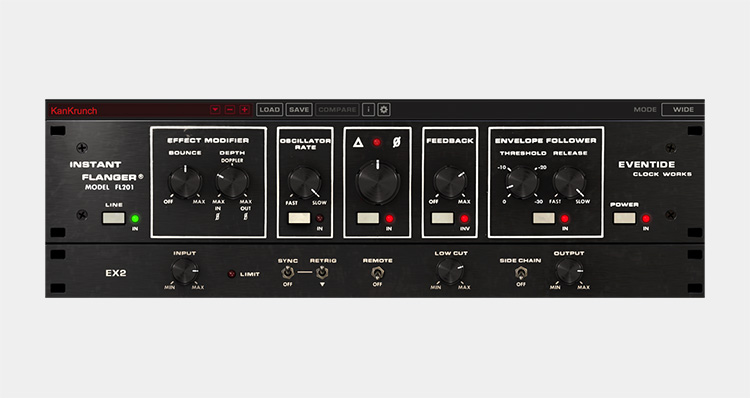
This VST plugin is a digital emulation of the Eventide Clockwork Instant Flanger from 1975, which offers three different sound variations: Shallow, Deep and Wide. This gives you more than enough playing possibilities.
You can choose another source for the modulation besides a normal LFO: Manual (to control the delay change yourself with the knob), Envelope (to select an envelope filter with ADSR controller as source) or Remote (to control the modulation with the mod wheel of your MIDI controller).
It's definitely worth buying this plugin, because for just 39€ you can apply it to an infinite number of tracks.
Boss BF-3 Flanger
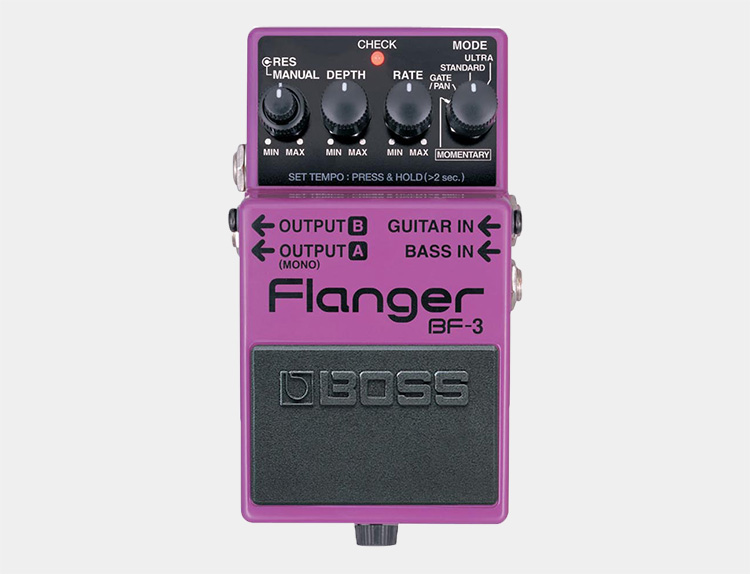
This pedal is a classic among guitarists. Boss has been building very good pedals for over 40 years. The Boss BF-3 is a further development of the Boss BF-2, which has been equipped with 4 new modes.
The new modes deliver impressive stereo sounds, making this pedal one of the best flangers on the market. But of course, for this you need two output cables and two guitar amps.
Besides the classic Depth, Rate and Resonance controls, this pedal has a manual controller that can change the central delay time of the effect. This can be used to create very interesting effects.
What does the manual control do in the flanger?
On flangers, the delay time of the wet signal is theoretically not influenced/changed by the LFO if you set the Depth control to minimum. The delay time of the wet signal behind the dry signal is therefore determined by the manual control and remains constant.
You should try it with Depth at minimum. Notice the difference in sound between Manual at Minimum and Maximum and especially how the sound changes when you move it.
On some effects units, when the manual is set to minimum, you can actually hear the difference between dry and wet, which sounds like a slapback delay or a doubling effect.
TC Electronic Thunderstorm Flanger

This effect unit can basically do the same as the one from Boss, but without stereo and without different modes. But it costs only a third of that.
The sound is very good and leaves nothing to be desired - especially when we look at the low price (49€). I like such simple but good effect units that are not equipped with too many functions that can confuse you.





